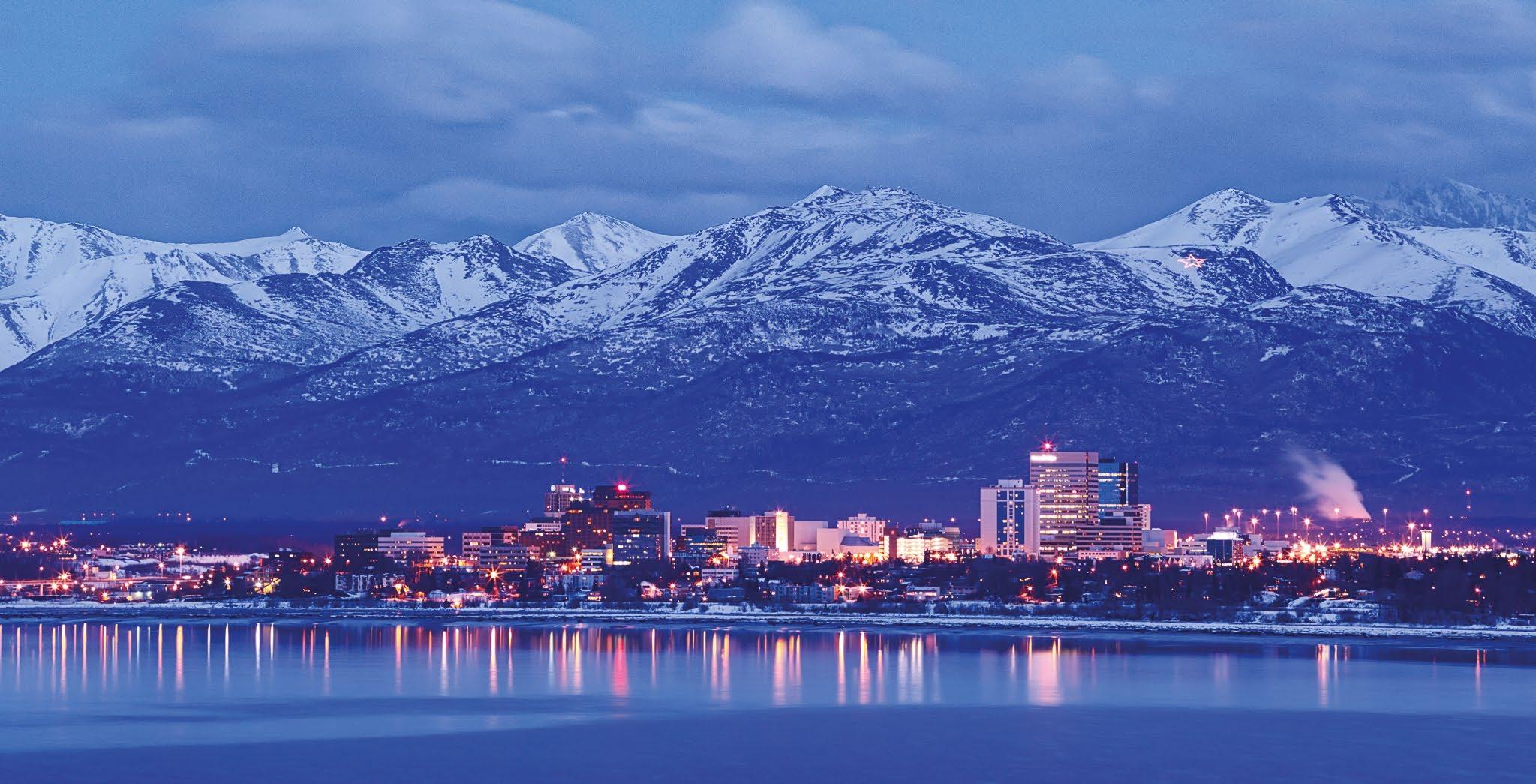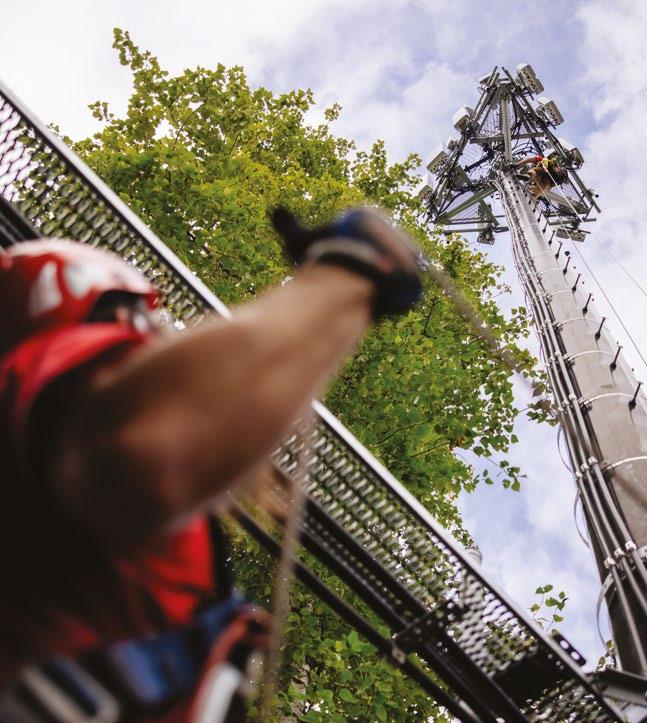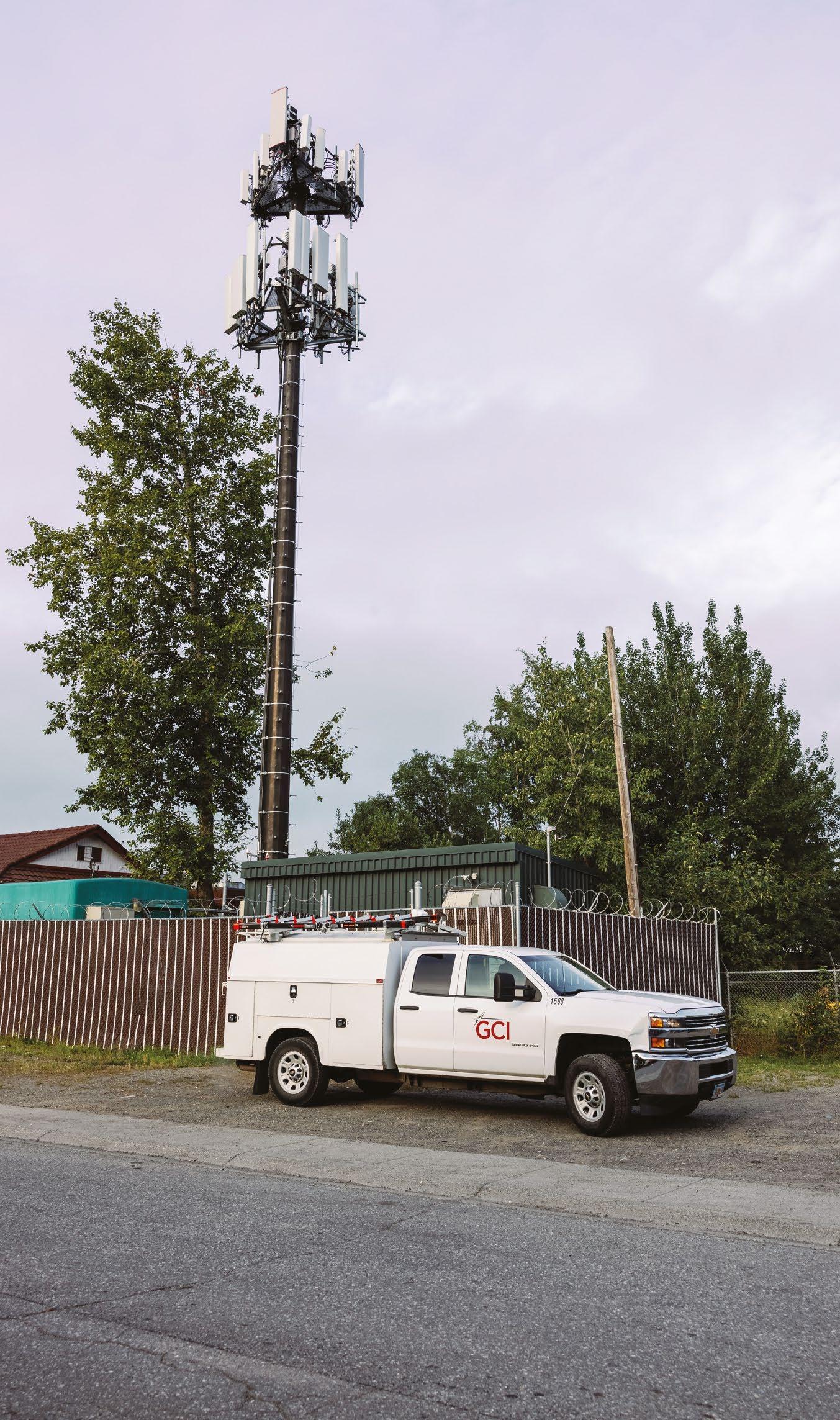
11 minute read
In Alaska, an investment in network modernization sparks transformation
Case study: GCI | Industry: Telecommunications
Executive summary
In the late 2010s, after more than three decades serving as Alaska’s largest communications company, while continuing to grow broadband market share, GCI found itself losing wireless customers. Its wireless network was fragmented, assembled through years of acquisitions, and wireless network performance was simply not meeting expectations. By 2019, GCI knew that drastic action was needed and took a fresh approach to its wireless strategy. Partnering with Ericsson, GCI committed to a network modernization project to bring fast, high-capacity 5G to the city of Anchorage, the company’s largest market. GCI and Ericsson rethought and redesigned the wireless network in Anchorage from the ground up. The combined team upgraded 76 macro cell sites in Anchorage — all within a year and a half, less than the planned two-year timeframe.
The solution deployed Ericsson’s Radio Access Network (RAN) Compute portfolio along with Ericsson Radio System radios. At the centralized core, Ericsson upgraded the network to activate features to support 5G services. GCI now has a powerful and efficient solution for providing higher data rates, a better user experience for subscribers and future-proof 5G capability for the company. The result: Customer churn was reversed, and GCI has experienced an unprecedented 15 consecutive quarters of postpaid growth.
GCI Communication Corp. (GCI) is a telecommunications service provider operating in Alaska. Founded in 1979 by Ron Duncan and the late Bob Walp, GCI provides data, mobile, video, voice and managed services to consumer, business, government and carrier customers throughout Alaska, serving more than 200 communities. Today, 97 percent of Alaskans live within GCI’s network, and 81 percent have access to the service provider’s 2.5 Gbps internet service.
Connecting a state as vast as Alaska isn’t simple. Alaska’s most advanced network covers more than 10,000 miles— larger than the state of Maryland. The varying and often remote terrain, in some of the most hostile environments in the world, can present daunting challenges to network builders. GCI and Ericsson have a long history of working together on innovative solutions to bring connectivity to the people in Alaska. The trust built over those collaborations led GCI to turn to Ericsson for help in modernizing the network.
Despite having a mere 730,000 residents, the state of Alaska is one of the most diverse states in the nation. Its population comprises Alaskan Native people, immigrant populations and many who came for opportunity or love of Alaska’s abundant nature. In addition to tourism, the state’s lifeblood is largely in the resource development sector—such as oil and gas, mining and fisheries—where connectivity is critical.
At a glance
Goal: Modernize GCI’s network to deploy Alaska’s first statewide 5G network with the highest availability and speeds in the Anchorage market.
Approach:
GCI partnered with Ericsson to rethink and redesign every cell site in Anchorage from the ground up.
Upgrade included foundations, power, shelters and cabinets, fiber-optic network extensions, all of the backhaul transport equipment, the baseband, the radios, the antennas and the tower structures at 76 macro cell sites.
Results:
Designed, installed and optimized a best-in-class 5G network in Anchorage in less than the projected two years.
Delivered Alaska’s first 5G network.
Greatly improved customer experience.
Achieved 15 consecutive quarters of postpaid growth.
The solution deployed:
Uses energy-efficient and high-performing radios coupled with Ericsson’s RAN Compute portfolio, delivering a futureproof 5G network.
Enables aggregation of spectrum capacity across multiple bands that provide higher data rates and better user experience for GCI’s subscribers.
Enables 5G functionality in GCI’s core network.
76 macros cell sites upgraded
2x faster speeds
15 consecutive quarters of postpaid growth

The challenge
When times are changing, it’s time to change
In the first decades serving the Alaska market, GCI grew quickly. In the late 2010s, however, GCI began experiencing an erosion of wireless subscribers, losing customers to its biggest competitor in the Alaskan market.
Identifying the problems
GCI assessed all factors to determine the extent of their challenges. They found:
Reliability challenges: The GCI wireless network was a patchwork of technologies, assembled over years of acquisitions with multiple generations of technology and many vendors. This multi-vendor, multi-tenant network bred a fragmented operational model, which made it very difficult for GCI to be proactive, diagnose troubles and then respond in a timely manner. Not surprisingly, service performance and reliability degraded. Performance in the radio access network and wireless core was simply not meeting expectations.
Limited capacity: By 2019, the capacity GCI provided in its network was not keeping up with customers’ data demands. Each of the multiple technologies in the network required its own spectrum. Yet only a fraction of GCI’s spectrum and acreage was deployed in the market. Its LTE network at the time did not leverage carrier aggregation and only provided a limited amount of capacity to each user. In addition, GCI’s backhaul network capacity was very constrained and didn’t have adequate bandwidth to meet their growing data needs.
Upshot: Dissatisfied customers. With their needs unmet and a less than-optimal experience, GCI’s customers were going elsewhere. GCI realized it needed to make a change and it couldn’t be minor or incremental. Success would require a transformational shift encompassing the entire wireless network and the entire GCI organization. GCI made a significant investment in transforming its culture and modernizing its network to turn the tide and become the most attractive choice for customers in Alaska.
The solution
As a company, we didn’t approach this modernization as business-as-usual. We could see that we needed to make changes in order to create a more sustainable future.
–Maureen Moore, Chief Customer Experience Officer, GCI
Modernize boldly and commit fully to 5G
In 2019, GCI decided to take a completely fresh approach to its wireless strategy. It began with what was called “Hometown 5G,” the Anchorage network modernization project. Anchorage is GCI’s biggest market and the state’s largest city, covering approximately 50 percent of Alaska’s population.
“The scope of the Anchorage modernization project is very bold,” said Chris Mace, Vice President of Technology Solutions and Chief Engineer at GCI. “We aimed to design and deploy the first statewide 5G network with the highest availability and the highest speeds in the market.”
That meant rethinking and redesigning every macro cell site in Anchorage from the ground up. GCI also committed to deploying all of its wireless radio frequency (RF) spectrum assets and all of its wireline fiber and transport backhaul capabilities in the project.
Finding a partner with global expertise and regional focus
GCI set a very aggressive timeline to upgrade and deploy a 5G network and core in Anchorage in less than two years. It needed a partner who could bring both the technology and the proven expertise to ensure a seamless transition to the new 5G network in that timeframe.
Having partnered with Ericsson to connect Alaskans for more than a decade, GCI trusted Ericsson’s unique combination of global experience building 5G networks, end-to-end solution breadth and understanding of the regional market. That gave GCI the confidence that the project would be completed on time and with a high degree of quality.
Ericsson’s modernization proposal aligned well with GCI’s vision and stood out in three key ways, according to Mace:
First, the proposal was comprehensive, including wireless RAN plus core as well as the operational elements to make sure that GCI could provide a quality service for years to come for its customers.
Second, the proposal contained both technical and financial elements to make sure that GCI could seamlessly transition from its current RAN and core network to its future network.
Finally, Ericsson provided 5G industry expertise that wasn’t readily available at the time. In addition, Ericsson had the construction capacity to make sure GCI could deploy its 5G network in Anchorage and meet the project’s very aggressive timelines.

Working together differently to meet the challenge
To ensure the 5G transformation in Anchorage in less than two years, GCI and Ericsson had to fundamentally change the way they worked together. They shifted from separate teams with separate project meetings to a fully integrated team co-located in Anchorage. The team held joint daily meetings with all of the engineering, construction and operations resources required to deliver the project.
Eric Boudriau, Head of Customer Unit Regional Carriers at Ericsson emphasized, “we worked very closely with GCI right from the start of the evolution of the network.” Ericsson collaborated with GCI to solidify the network strategy, the definition of the requirements and the execution of the project.
“A game changer for the project,” Mace reported, “was Ericsson sourcing a wireless construction subject matter expert to fill a key GCI project leadership position. This expert was able to navigate both GCI and Ericsson to make sure all of the resources between the two companies worked as effectively as possible to ensure we met the objectives of the project.”
Based on the subject matter expert’s recommendation and in collaboration with the project team, GCI and Ericsson were able to adapt to the challenges that arose, adding key resources as needed for the project. This integrated team succeeded in upgrading foundations, power, shelters and cabinets, fiber-optic network extensions, all of the backhaul transport equipment, the baseband, the radios, the antennas and the tower structures at 76 macro cell sites in Anchorage within a year and a half.
Modernizing the enterprise along with the network
“In addition to upgrading the network, we recognized that as an enterprise, we needed to make some structural changes so the whole organization would be ready at the moment the network improvement was complete,” said Maureen Moore, GCI’s Chief Customer Experience Officer. GCI created a cross-functional working group that brought all of the necessary parties to the table so everything would move forward as the network was being upgraded.
Simultaneously with the network upgrade, GCI invested heavily in its retail store experience training, getting everyone ready. “We wanted it to be fun for our customers and our employees,” Moore emphasized. “We had a whole campaign around ‘Hometown 5G’ that got people amped up and excited about the greatly improved network that they were about to experience.”
We prepped ourselves to be ready when the network upgrade was done so that we could welcome customers.
–Maureen Moore, Chief Customer Experience Officer, GCI
Ensuring future-proof 5G capability
The solution deployed uses Ericsson’s RAN Compute portfolio along with Ericsson’s Radio System and enables the aggregation of spectrum capacity across multiple bands. At the centralized core, Ericsson upgraded the network to activate features to support 5G services. In this way, GCI and Ericsson created a powerful and efficient solution for providing higher data rates and better user experience for GCI’s subscribers and future-proof 5G capability for the company.

Results
Faster speeds for more Alaskans and super growth for GCI
The modernized network deployment in Anchorage set the foundation for future opportunities at GCI. Not only did it deploy a significant amount of low- and mid-band spectrum, but it also added the backhaul transport capacity with fiber extensions and enabled 10 gigabits per second of backhaul capability to every site. GCI is now positioned for today’s enhanced mobile broadband use cases, and it’s well prepared for future use cases for consumer and business in both mobility spaces and the fixed broadband area.
With a blazing fast, high-capacity new 5G network, GCI now found itself strategically positioned to offer high-speed data and improved 5G wireless service. Capitalizing on its leadership as Alaska’s largest internet provider, GCI created a highly successful signature premium product called GCI+ that combines wireless lines plus high-speed data.
“The results we achieved as a result of investing in our network exceeded even what our expectations were,” said Moore. “We’ve had 15 consecutive quarters of postpaid growth and seen a significant reduction in churn on customers who choose GCI+. We have our eyes on the future as we expand our 5G network to other parts of Alaska.”
What’s next for GCI and Ericsson’s partnership?
GCI and Ericsson’s partnership continues to expand beyond the Anchorage modernization project. Together, they are continuing to deploy 5G RAN network statewide and to provide geo diversification to GCI’s core wireless network while looking at future ways to further integrate the wireless and wireline networks. “We’re also working on providing innovative solutions such as local packet gateways, innovative solutions to reach even further remote and isolated communities,” added Boudriau. “That’s GCI’s core mission, and we’re proud to be helping them do that.”
Ultimately, GCI’s customers will benefit most. As the modernization project expands in and beyond Anchorage, Alaskans will see more life-enhancing services delivered to more underserved and remote communities throughout the great state of Alaska.



